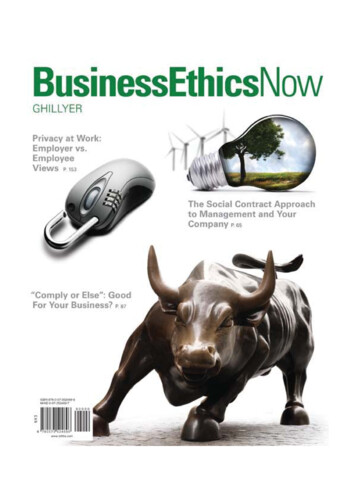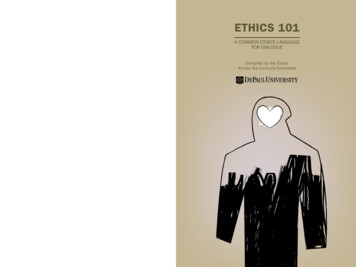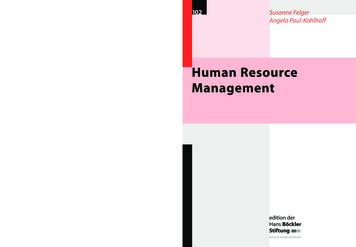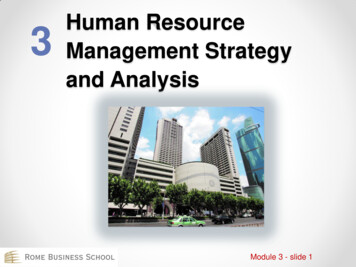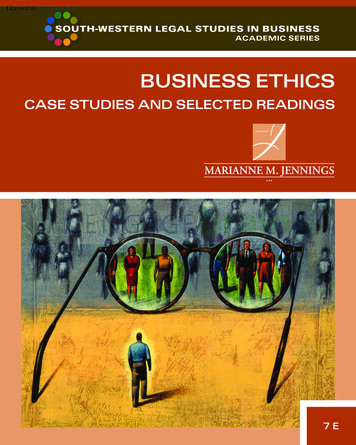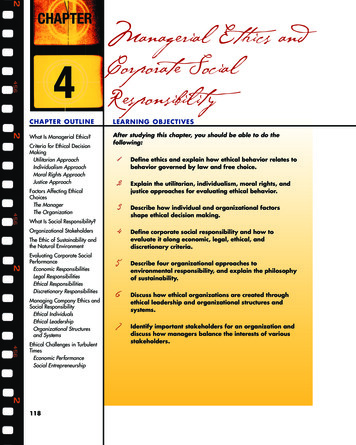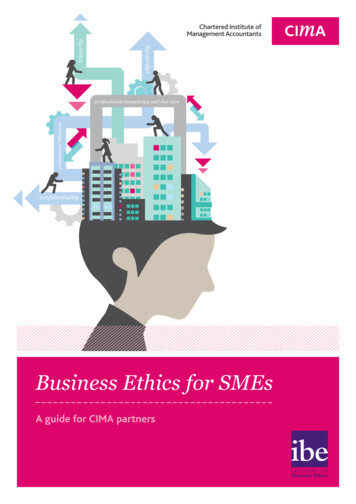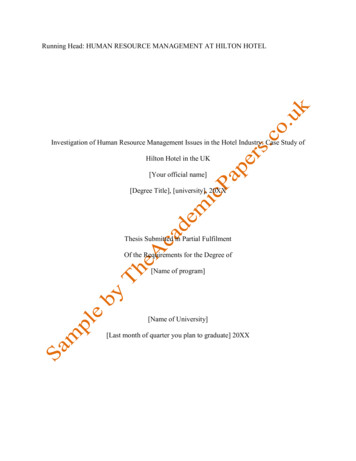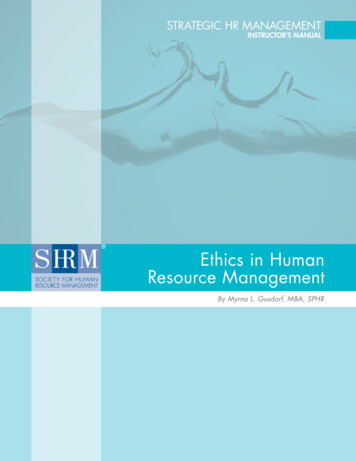
Transcription
Strategic HR Managementinstructor’s ManualEthics in HumanResource ManagementBy Myrna L. Gusdorf, MBA, SPHR
PROJECT TEAMAuthor:Myrna L. Gusdorf, MBA, SPHRSHRM project contributor:Bill Schaefer, SPHR, CEBSExternal contributor:Sharon H. LeonardCopy editing:Katya Scanlan, copy editorDesign:Shirley E.M. Raybuck, graphic designer 2010 Society for Human Resource Management. Myrna L. Gusdorf, MBA, SPHRNote to HR faculty and instructors: SHRM cases and modules are intended for use in HR classrooms atuniversities. Teaching notes are included with each. While our current intent is to make the materials availablewithout charge, we reserve the right to impose charges should we deem it necessary to support the program. However,currently, these resources are available free of charge to all. Please duplicate only the number of copies needed,one for each student in the class.For more information, please contact:SHRM Academic Initiatives1800 Duke Street, Alexandria, VA 22314, USAPhone: (800) 283-7476 Fax: (703) 535-6432Web: www.shrm.org/education/hreducation10-0660
IntroductionThis learning module is designed to be presented in four class sessions ofapproximately 50-90 minutes each. The material is appropriate for undergraduate orgraduate students studying human resource or business management. Five integratedcases allow students to practice resolving HR problems using the ethical principlesintroduced in the module. The first two sessions provide instructional material onethical theories and moral development. Session 3 is for presentation and discussionof the cases, and the last class session addresses the HR professional’s responsibilityfor the organization’s culture of ethics. The module includes an instructor’s manualwith cases and teaching notes and a PowerPoint presentation for classroom use.Module Learning ObjectivesBy the end of this module, students will:nnCompare and contrast various ethical theories.nnUse ethical theories and principles in the decision-making process.nnApply ethical principles to analysis of HR case problems.nnIdentify various solutions to ethical case questions.nnDefend their recommended solutions using the ethical theories discussed in themodule.Required ReadingsTextsDeckop, J. R. (2006). Human resource management ethics. Greenwich, CT:Information Age Publishing, Inc. Chapters 3, 4, 6 and 14.Johnson, C. E. (2007). Ethics in the workplace. Thousand Oaks, CA: SagePublications, Inc. Chapters 1, 2, 3 and 9.ArticlesCrain, W.C. (1985). Kohlberg’s stages of moral development. In W.C. Crain, Theoriesof development (chapter 7, pp. 118-136). Boston, MA: Prentice Hall. RetrievedJanuary 11, 2010, from: chumann, P. L. (2001). A moral principles framework for human resourcemanagement ethics. Human Resource Management Review, 11, 93-111. 2010 Society for Human Resource Management. Myrna L. Gusdorf, MBA, SPHR 1
White, R. D. (2002, Winter). Do employees act like they think? Exploring thedichotomy between moral judgment and ethical behavior. Public AdministrationQuarterly, 391-412.Class StructureClass 1: Ethical TheoriesQQLearning objectives.QQEthics and morals.QQEthical theories.QQEthical relativism.QQUtilitarian theory.QQCategorical imperative.QQDistributive justice.QQEthics of care.QQAristotle’s virtue ethics.Class 2: Moral DevelopmentQQKohlberg’s stages of moraldevelopment.QQMoral judgment and moral conduct.QQDo moral people behave unethically?QQEthical decision-making.Class 3: Discussion of CasesQQWhen the Boss Doesn’t Like Her.QQNow You See It, Now You Don’t.QQReal Sales or Wishful Thinking?QQThe Best Person for the Job.QQWhat Ever Happened to Lana?PowerPoint SlidesSlides 1–11.Instructor notes are found in the“Notes” view on the slides.PowerPoint SlidesSlides 12–23.Instructor notes are found in the“Notes” view on the slides.Required ReadingsSchumann.Deckop, Chapter 3.Johnson, Chapter 1.Required ReadingsCrain.White.Deckop, Chapters 6 and 14.Johnson, Chapters 2 and 3.PowerPoint SlidesRequired ReadingsNone.Students should read the cases beforethis class session.2 2010 Society for Human Resource Management. Myrna L. Gusdorf, MBA, SPHR
Class 4: HR Management andEthical OrganizationsPowerPoint SlidesRequired ReadingsQQHuman resource practices.Slides 24–35.QQBuilding a culture of ethics.QQLong-term results.Instructor notes are found in the“Notes” view of the slides.Deckop, Chapter 4.Johnson, Chapter 9. 2010 Society for Human Resource Management. Myrna L. Gusdorf, MBA, SPHR 3
Using the CasesThe cases present HR dilemmas that frequently occur between staff and first-levelmanagers. They are intended to provide students opportunities to practice resolvingreal HR challenges and to apply the principles identified with various ethical theoriespresented in this module. It is recommended that students analyze each case fromthe perspective of several different ethical theories. In this way, students will realizethat there is often no “one best” resolution to management problems. By using avariety of approaches, students can generate multiple resolutions that may result indifferent outcomes, yet still reflect valid, ethical reasoning. Accompanying the casesis a worksheet, “Assessing Alternatives Ethically” (pages 18-19). The worksheetincludes questions that help students think through the case issues using the ethicaltheories presented in this module. The instructor may find the questions useful tostimulate ideas and classroom discussion.Group Activity by CaseTeam PresentationsDivide students into teams and assign one case per team. Teams of four or fivestudents generally work best, but the size of your teams will vary depending on classsize. Ask students to resolve the issues presented in their assigned cases, applying thevarious ethical perspectives discussed in class. Teams will present their recommendedsolutions to the class. Teams should be prepared to defend their recommendationsethically. Assign the teams and the cases during the first class and schedule the teampresentations for the third class. Students should read all the cases before the thirdclass so they can ask informed questions.Group ActivityThis activity can be completed in one class session and is a less formal alternativeto the team presentation. Ask students to read all the cases before the third class.For the class activity, divide students into groups and assign each group onecase. Ask the group to generate solutions for the issues in their case and reporttheir recommendations back to the class. Ask them to identify their primaryrecommended solution and defend it according to ethical theories.4 2010 Society for Human Resource Management. Myrna L. Gusdorf, MBA, SPHR
Group Activity by Ethical TheoryActivity 1Divide students into teams of four or five, depending on class size. Assign each teamone case. Ask them to analyze the case and generate solutions. Ask teams to thenassess their solutions based on each of the five ethical theories presented in class andgenerate one recommendation for each principle. Teams may come up with differentrecommendations based on the principles of different ethical theories. Ask them todefend each recommendation ethically, even if their recommendations differ.Activity 2Divide the class into groups based on ethical theories, with each group representinga different theory. Have each group analyze all five cases using only the ethicaltheory and principles they were assigned and then report back to the class. Discussthe group results by case and not by group. For example, have all the ethical groupsreport back on the first case before moving to the next case. Ensure each teamdefends its recommendation according to the ethical theory assigned to the groupand discuss the differences.Written ActivityIf in-class time is limited or you prefer a written assignment, have students provide awritten analysis of the cases using the questions in “Assessing Alternatives Ethically.”Their papers should be due during the fourth class. Move the discussion of HR’s rolein organizational ethics to the third class and reserve the fourth class for discussionof student papers.Student MaterialsInstructors should copy pages 6-19 of this manual and distribute them to thestudents. These pages include learning objectives, required readings, the fivecases and the questions to help analyze the cases. Include any other instructionalinformation specific to your class that students will need to complete theassignments. 2010 Society for Human Resource Management. Myrna L. Gusdorf, MBA, SPHR 5
Ethics in Human Resource ManagementLearning ObjectivesBy the end of this module and accompanying cases, students will:nnCompare and contrast various ethical theories.nnUse ethical theories and principles in the decision-making process.nnApply ethical principles to analysis of HR case problems.nnIdentify various solutions to ethical case questions.nnDefend their recommended solutions using the ethical theories discussed in themodule.Required ReadingsTextsDeckop, J. R. (2006). Human resource management ethics. Greenwich, CT:Information Age Publishing, Inc. Chapters 3, 4, 6 and 14.Johnson, C. E. (2007). Ethics in the workplace. Thousand Oaks, CA: SagePublications, Inc. Chapters 1, 2, 3 and 9.ArticlesCrain, W.C. (1985). Kohlberg’s stages of moral development. In W.C. Crain, Theoriesof development (chapter 7, pp. 118-136). Boston, MA: Prentice Hall. RetrievedJanuary 11, 2010, from: chumann, P. L. (2001). A moral principles framework for human resourcemanagement ethics. Human Resource Management Review, 11, 93-111.White, R. D. Jr. (2002, Winter). Do employees act like they think? Exploring thedichotomy between moral judgment and ethical behavior. Public AdministrationQuarterly, 391-412.Student Assignment: Using the CasesYour instructor will assign the cases. At your instructor’s discretion, you may beworking alone or in groups to analyze the ethical issues and recommend solutionsto the problems presented in the cases. The worksheet, “Assessing AlternativesEthically,” is included in this handout along with the case studies. The worksheet6 2010 Society for Human Resource Management. Myrna L. Gusdorf, MBA, SPHR
includes questions to consider as you work through the cases. It may be helpful toread through the questions on the worksheet before reading the cases.Alone or in teams, the project requires that you:nnCarefully read your assigned case(s).nnIdentify the stakeholders involved in the case.nnSuggest possible solutions to the issues described in the case.nnnnnnnnIdentify challenges that various stakeholders may encounter with your suggestedalternatives.Assess your suggested alternatives using the ethical theories and principlesdiscussed in the class.Use the questions on the “Assessing Alternatives Ethically” worksheet todetermine which of your alternatives will result in ethical solutions.Present your recommended solutions to the class, either orally or in written form,as directed by your instructor. 2010 Society for Human Resource Management. Myrna L. Gusdorf, MBA, SPHR 7
Case 1: When the Boss Doesn’t Like HerAnna is the office manager for a Grocery Distribution warehouse in Ft. Myers,Fla. Anna’s facility is part of a large Atlanta-based conglomerate that wholesalesand distributes gourmet specialty food products throughout the southeasternUnited States. Anna’s been at Grocery Distribution for four years, starting as anadministrative assistant in the sales department. She was promoted to office manager18 months ago and reports directly to the district manager, Justin. Anna likes herjob. She enjoys her co-workers and hopes to make a long-term career at GroceryDistribution. As a single parent of two young daughters, she was delighted with thesalary increase that came with her promotion. Justin is a new district manager for theFt. Myers facility. He has made some changes in the structure of the organization,which, for the most part, have been well received by the staff.Janet is the receptionist. She works at the front desk, greeting visitors, schedulingappointments and taking care of the mail. Anna is Janet’s supervisor. Janet recentlywent through a difficult divorce, and now that she lives alone, Anna knows thatJanet struggles to make ends meet on her receptionist’s salary. Outside of work,Janet is active in community theatre. At Janet’s most recent opening night, Annaand several other Grocery Distribution employees were in the front row of thetheatre cheering on Janet’s starring performance. Janet had some rough patchesduring the divorce, when she was understandably distracted, but overall, Anna ispleased with Janet’s work. Janet has received positive performance appraisals.Justin does not like Janet. He claims that she is careless and makes far too manymistakes, and with her casual attire, she doesn’t “look good” at the front desk.“Besides,” he says, “she’s not really that interested in her job. That communitytheatre thing takes way too much of her time.” When Janet asked to take themorning off the day after her opening night, Justin commented that now she’sundependable and insisted that Anna talk to Janet about it, even though Janetseldom misses work and her absence that morning was easily covered by other staff.Friday morning, Anna is called into Justin’s office. It has been a busy week becauseJustin is getting ready to leave for a two-week vacation. Several projects must becompleted or offloaded to other staff before he leaves. It was decided that Annawould take care of some of Justin’s projects while he is gone, and she is confidentthings will go well in his absence.While Anna is gathering up her papers at the end of the meeting, Justin says,“There’s just one more thing, Anna. While I’m gone, I want you to documentJanet’s poor performance and write up an appraisal on her. Have the paperwork onmy desk and ready for me to sign when I get back, and then you can terminate her. Iwant her out of here within the next 30 days.”8 2010 Society for Human Resource Management. Myrna L. Gusdorf, MBA, SPHR
Anna is stunned. She knows Justin dislikes Janet, but she is not sure how she candocument Janet’s “poor” performance because she believes Janet is a good employee.Any time she has talked to Janet about Justin’s concerns, Janet has tried to improve.Janet knows Justin does not like her, and she has made it clear to Anna that if Justinhas any problems with her work, she wants to know immediately so she can correctthe problem. “I don’t want to lose my job,” she’s told Anna.Anna wonders what to do. Grocery Distribution has a published Code of Ethics,and there is an HR department at headquarters in Atlanta, but there is no HRrepresentative at Anna’s facility in Ft. Myers.What would you recommend to Anna? What consequences may occur as the result of heractions? 2010 Society for Human Resource Management. Myrna L. Gusdorf, MBA, SPHR 9
Case 2: Now You See It, Now You Don’tJohn is the facility manager for Harrell Construction, a privately owned constructioncompany. The company employs 35 people and is owned by Alan Harrell and hiswife, Mary. John has been at Harrell Construction for four years. It has been a goodspot for John after a series of short-term construction jobs that either went nowhereor ended when the small companies he worked for were out-maneuvered by largerorganizations and closed.As the facility manager, John runs the shop and manages all of Harrell’s equipment.He inventories equipment and supplies, schedules equipment for various jobs, checksequipment back in, and makes sure it is repaired and ready for use for the next job.John runs a tight ship. The facility is organized and clean, and his attention to detailhas cut time loss from malfunctioning or unavailable equipment to nearly zero.Alan has been pleased with John’s work, and over the course of John’s employment,Alan and John have become good friends. They do not socialize outside of work, butthey often eat lunch together and on occasional afternoons, you’ll find them out onthe golf course. “John’s a good man,” Alan says, “The shop has never been in bettershape, and his records are meticulous. I finally know what I own and where it is.”“The Harrells are great people to work for,” John says. “Mary doesn’t come aroundthe office much, but we see her at the company picnic in the summer and at theannual holiday party. They put on quite a bash for employees. It’s always a familyevent. Their two teenage boys always come to the events, and everyone’s family iswelcome. My wife and kids love it. We always have a good time.”“Besides that, the compensation is fair. The Harrells are right in line with whateverybody else pays,” John adds. “The benefits are good, too. Don’t know what Iwould have done without the health insurance when my wife went through chemotwo years ago. I plan to stay with Harrell Construction long term if I can. I’ve gottwo kids headed for college and retirement to think about, and this is a good placewith a future.”Things aren’t always as perfect as they seem, though. Yesterday at lunch Alanconfided to John that he and Mary were getting a divorce. “She’s never had anyinterest in this business,” Alan said. “She has never helped out in the shop, even inthe early years, when we were really struggling. But she’s got a sharp lawyer, and Iknow she’s going to claim half the company.”“I need you to help me out, John,” said Alan. “The company’s biggest asset is ourequipment. Mary doesn’t know what we’ve got, and with the equipment out ondifferent job sites, nobody ever sees all of it except you. I want you to get out thoseinventory sheets and make some of those high-priced lifts disappear. I’m worried10 2010 Society for Human Resource Management. Myrna L. Gusdorf, MBA, SPHR
there won’t be anything left after her lawyers get done with me. I’d hate to thinkwe’d have to close down and leave everybody out of a job.”As is common with many small, privately owned organizations, there is no formal HRdepartment at Harrell Construction, and Alan Harrell has always made the decisions.What is John going to do? 2010 Society for Human Resource Management. Myrna L. Gusdorf, MBA, SPHR 11
Case 3: Real Sales or Wishful Thinking?Robert sells shipping supplies for a warehouse supply wholesaler in Denver. He hasbeen with Warehouse Supply for almost a year, hired fresh out of Collegiate U witha degree in marketing. Robert says it is his dream job. He always wanted to be insales, and he loves the organized chaos of a warehouse as trucks and freight move inand out. He has a real understanding of warehousing, learned while he was workingsummers and part time as an order picker in a club store warehouse. He workedthere until his junior year at Collegiate, when he had the accident on Highway 17that left him a paraplegic. After the accident, he spent months in rehabilitationand had to take some time off from school. Then, because he was in a wheelchair,he could not go back to his job as order picker in the warehouse. He still got hismarketing degree, though. It just took him a little longer.“I really like sales,” Robert says, “It gets me out and about, and I enjoy workingwith the customers. I was afraid my wheelchair would put people off, and I’d bestuck behind a desk for the rest of my life. I’d hate that. I’m thankful that I havethe accessible van and can drive my own route. I know I’m a little slower than someof the guys, but I think I’ve earned their respect, and I like the challenge. I don’talways make the numbers, but people need to know that there is a lot more that aparaplegic can do than what he can’t do.”Unfortunately, sales have been down for Warehouse Supply for the last two quarters.When consumers buy less merchandise like toys, clothes, gadgets, etc., there arefewer shipments in and out of warehouses and less demand for warehouse supplies.Like most other sales organizations, Warehouse Supply compensates its sales staffwith commission and bonuses in addition to base salary. Besides the sales staff,management-level employees also receive bonuses based on sales numbers. Whensales shrink, everybody feels the pinch.Marty is the sales manager for Robert’s district. When Marty interviewed Robert forthe job, he was impressed with Robert’s knowledge of warehousing, his enthusiasmfor sales and his outgoing personality. He’d never hired anyone in a wheelchairbefore, but he thought, “What the heck, I think this guy can do the job, and weshould give him a try.” Robert learned fast, and once the customers got used to theidea of a guy in a wheelchair in the warehouse, things seemed to be fine, althoughMarty had to admit that Robert’s sales numbers were never outstanding. Mostmonths, Robert’s sales are at or near the bottom of the pack. “He’s just a littleslower,” Marty said. “By the time he gets that van parked and gets his chair in andout, he just can’t get around to as many customers in a day as the other guys. But hedoes all right, and he makes a lot of calls from the office. Can’t say he’s not on top ofhis customers needs. He takes good care of them.”12 2010 Society for Human Resource Management. Myrna L. Gusdorf, MBA, SPHR
With sales down, Marty is getting pressure from Frank Bishoff, Warehouse Supply’svice president of sales at the home office in Phoenix, Ariz. Frank is always a littleedgy when bonuses are due, but this time he is really on Marty. He called again thismorning. “Hey Marty, what’s going on out there? All I see is inventory stackingup and your sales numbers going down! I know everybody’s sliding a little in thiseconomy, but your second quarter numbers are terrible. You’ve got to move someproduct, and move it now! I’m getting pressure from the guys upstairs. You knowthat everybody’s bonus is riding on this, and we’re nearly at the end of the quarter.I’ll be in Denver at the end of the month. We’re taking a closer look at your numbersand your people. You’d better tell anybody who’s not up to speed that it has got tochange—or they’re going to be gone. Whatever it takes, Marty, get those numbersin now!”Marty has three weeks before Frank comes to Denver. “Heck, if they’ll just take iteasy until the next quarter, we’d be fine,” thinks Marty. “I know our numbers area little flat right now, but we’ll have big orders next quarter, when Quality Retailbuys for their anniversary sale. I just wish we had those numbers now; then Frankand his cronies would leave us alone. I think I’ll give Robert a call. Quality Retail ishis account. If he’d just write up their anniversary sale orders today and get them inthe system, we’d all be off the hook. Why not? Frank said whatever it takes. We canalways back the numbers out at the end of the quarter if need be, and Robert cansquare up the account with Quality later. Besides, he might just save his own job.Why should I take the heat alone? It’s time he knew Frank has always thought it wasa lousy idea to hire a guy in a wheelchair. Maybe Robert does belong in a desk job.”Warehouse Supply’s HR department is located at the home office in Phoenix, andMarty has never had anything to do with HR. A representative from Phoenix comesto Denver occasionally to do some training—usually sexual harassment—and Martyknows there is an employee handbook, but he’s never read it beyond the statementhe signed concerning employment-at-will. Considering the pressure he is under fromFrank, he believes the focus for sales at Warehouse Supply is on making the numbersand not much else.“There’s no harm in getting the orders in early,” Marty muses. “Besides, we canalways back the numbers out later if we need to. And this way everyone gets theirbonuses. Isn’t that what they really want anyway?”Is there an ethical issue here? If so, what is the issue and how should it be addressed? 2010 Society for Human Resource Management. Myrna L. Gusdorf, MBA, SPHR 13
Case 4: The Best Person for the JobAfter 25 years, Art is finally ready to retire and take it easy. Art teaches accountingand general business courses at Youngstown Community College. The businessdepartment at Youngstown offers business administration classes transferable toState University as well as professional and technical programs that culminate in acertificate after one year of study or an associate’s degree after two years of study.Youngstown has a dual enrollment agreement with State, and as a result, manybusiness students at Youngstown are also enrolled at State.Art teaches several of the business transfer classes at Youngtown, but his reallove is the non-transfer professional accounting program. He was part of thefaculty that created the program, and over the years he has taught hundreds ofaccounting students and helped them obtain internships and find employment in thecommunity. Art’s golfing buddy sometimes jokes that every bookkeeper in town hasbeen through Art’s accounting classes.Besides the regular accounting classes and internships, Youngstown maintains anaccounting lab where students can get tutoring help if needed. The current lab tutoris David, who was hired two years ago when Dianne retired after nearly 10 yearsas the accounting tutor. David is a former student of Art’s and holds an associate’sdegree from Youngstown and a bachelor’s from State. The lab job is part-time,which works out perfectly for David, leaving him plenty of time to pursue his MBAin accounting at State. David wants to teach accounting at Youngstown when hecompletes his MBA.As a tutor, David has brought the accounting lab to life. He relates well withstudents, is an excellent tutor, and the faculty sees him as a valuable member of thedepartment. In the two years he has worked in the lab, David has become goodfriends with Evan, the business department dean. They frequently have lunchtogether and even socialize with their wives outside of work. Last summer thefamilies went camping together over the 4th of July, and this year they expect to dothe same.Evan is chair of the committee to find Art’s replacement. The committee consists ofEvan, two additional faculty members, an administrator from another departmentand Mary, the department chair for business and accounting. On Monday morning,Mary met with Evan to plan out the recruitment process.“I know HR requires us to do a job search,” said Evan, “but even so, there’s noreason why we can’t move David into Art’s position. He relates well with ourstudents, knows all the ins and outs of the college, and is well liked by the faculty.”14 2010 Society for Human Resource Management. Myrna L. Gusdorf, MBA, SPHR
Mary is surprised at Evan’s suggestion. “David is a nice guy, and we all like him,” shesaid, “but he’s not qualified. This position requires a master’s degree, and he’s onlygot a bachelor’s.”“He doesn’t need a master’s degree to teach in the professional/technical program,”said Evan. “He’s perfectly qualified for that, and we have plenty of other faculty thatcan teach the transfer program. David is in school anyway. He’ll get his MBA nextyear, and until then, we’ll just schedule him for the professional/technical program,and we’ll fit the other classes into other faculty members’ schedules.”“This is not how we normally replace faculty,” said Mary. She was particularlydisturbed that Evan’s attitude indicated it was a done deal.“It’s no problem,” said Evan. “Recruitment is just an HR exercise anyway. I’ll havethe paperwork ready for your signature by tomorrow.”The paperwork, marked “confidential,” was in Mary’s mailbox the followingmorning. It contained all the documents necessary for HR to launch a full-scalerecruiting plan, including a new job description written by Evan. Instead of thecustomary broad-based job description for a faculty member qualified to teachuniversity-transferable and non-transfer classes, Mary found a job description thatdescribed David exactly.“This is a set-up,” Mary mumbled to herself. She knows that even with five memberson the hiring committee and the required selection process, the actual hiringdecision is left to the dean. “It looks like David’s got the job no matter what. Whatgood is Youngstown’s ethics committee when the deans have the power to do as theyplease anyway?”What should Mary do? 2010 Society for Human Resource Management. Myrna L. Gusdorf, MBA, SPHR 15
Case 5: What Ever Happened to Lana?Once the rumor mill in the business department at Youngstown CommunityCollege got wind that the dean, Evan Comstock, wanted to move David into thefaculty position vacated by Art’s retirement, it was all anyone could talk about. Noone was surprised at Evan’s intention because he had taken David under his wingtwo years ago when David was hired as the tutor in the accounting lab. Evan andDavid had become good friends since, and there had been previous instances offavoritism that left everyone feeling uneasy, but this was really too much.The problem was that Art’s position required an MBA in accounting, and Davidhad only a bachelor’s degree. Although David was enrolled in an MBA program atState University, he wouldn’t be finished for at least another year. Until then, hewould only be qualified to teach professional and technical accounting courses andnone of the classes that transfer to State. The rest of the accounting faculty wouldhave to pick up the slack until David finished his MBA. It would increase everyone’sworkload and create a scheduling nightmare. While everyone liked David and agreedhe was a great tutor, there was a lot of grumbling.They didn’t have to grumble for long. Evan had rewritten Art’s job description toensure that David would qualify. When the new, watered-down job descriptionlanded on vice president Schilling’s desk, he called Evan immediately. Schilling wasnever one to mince words. “Evan, what are you thinking over there?” he shouted,and that was the end of Evan’s plan for David.The position still had to be filled, so HR con
currently, these resources are available free of charge to all. . Human Resource Management


